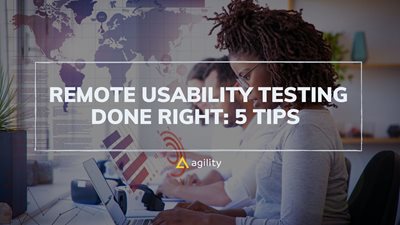Remote Usability Testing Done Right: 5 Tips
The remote usability testing guide


Working on a product takes companies through a long journey with numerous essential stops along the way. One of the critical steps to ensure that your product is performing as intended is user testing.
The process brings many benefits to the table, making usability testing a process that all serious companies rely on in their product development.
This article will explain what user testing is, what types of user testing there are, and the best tips to get great results.
Keep reading to discover all the essential things to consider before you start your usability testing.

What is remote usability testing?
Usability testing is a process during which your select testers try out your platform. During the testing phase, you can request feedback from your testers to learn about your platform’s shortcomings when it comes to usability.
To simplify the process of remote usability testing, companies rely on usability testing software. Using these tools allows businesses to bridge the gap of working remotely with your testing group.
After you finish the whole process, you’ll know what you can do to improve your product and get it one step closer to the launch. It’s just one of many benefits of technology implementation in business procedures.

Types of remote usability testing
Remote usability testing can be either moderated or unmoderated. On the other hand, it is also classified into comparative, explorative, and assessment. Let’s explore what these types of user testing are.
1. Moderated vs unmoderated
Moderated usability testing means that someone is there to guide the testers through the testing process. Several benefits make the moderated approach appealing.
For example, picking this approach will ensure that the usability testing goes smoothly and you get the desired results. The moderators can request feedback from the people to see their potential pain points that show where your product needs improvement.
The unmoderated approach means that there’s no one to guide the users who are testing your product. To compensate for the lack of a moderator, create highly detailed testing scenarios with all the details and create a plan on how you’re going to acquire user feedback.
There’s no right or wrong approach. It all depends on the type of project and what works best. If you’re looking for a massive user testing audience, an unmoderated approach is an excellent option as you can quickly scale your testing needs.
On the other hand, making sure that testing goes through the exact steps requires moderation.

2. Comparative, explorative, and assessment
As you might assume, comparative user testing includes a comparison of two different platforms. If you want to see how well your product is holding up against the competitors, you’ll use this type of testing method.
Explorative testing is perfect for the beginning stages of your software products. The participants contribute by stating their thoughts about the concept.
Last but not least, assessment tests are standard in the tech industry. These tests are essentially the participants’ assessment of your complete or almost complete product. The test shows the usability of your product.
Helpful tips that’ll bring great results
To ensure that the testing process goes smoothly, it’s necessary to plan every step of the way carefully. The following tips will help you create a perfect remote usability testing approach, allowing you to gather all the relevant data about your platform’s usability.
1. Set a goal and limit the scope of the test
Who is going to be using your product? Think of your target audience and mark which parts of your digital product you want to test. Is your graphic design intuitive enough? Is the call to action clearly visible? Can the user quickly navigate through your application?
Your testing needs to answer some of the mentioned questions.
Furthermore, focus on a single part of your product. The last thing you want is for your participants to test the whole product for 2 or 3 hours. It’s better to create tests that will require 10-15 minutes but probe specific issues. That way, the participants will stay more focused and carefully assess the product.

2. Be thorough with your script
Remote usability testing can only deliver great results if you create easy-to-follow scenarios that define the tester’s role. The goal is to create a scenario under which your tester is going to use your app.
Include plenty of details in the scenario so the user knows which part of the product they should analyze.
For example, if you’re building a food ordering app, simply provide a scenario where the user is hungry at home. All they should do is open the app and make an order. Also, instruct them to add side orders, choose quick delivery, or use any available features.
The more details you include, the better you can formulate more questions about their experience with your product.
3. Find the testers you need
Invest a lot of time to find testers who resemble your target audience. If you’re making an app for small business owners, they should be doing all the testing. On the other hand, if you’re building an app for broader audiences, consider working with people from different walks of life.
There’s no point in simply hiring any person to do your usability testing. For example, younger testers might find everything about your platform intuitive. However, your usability testing results are irrelevant if your target audience is males in their 40s and 50s.
4. Use a lot of testers
Use as many testers as you can in your usability testing procedure. With an increased sample of people, you’ll have more feedback to analyze. You’ll more easily notice patterns in user behavior, detect a lack of usability and easily measure overall satisfaction with their use of your product.
Another thing to consider is that not everyone is going to do your remote usability testing. As you’re not conducting testing in person, people are more likely to skip testing your product.
With more people, you still get a lot of feedback even if someone doesn’t show up.
5. Create a feedback acquisition strategy
Remember to focus on receiving feedback. With moderated usability testing, this is easier as moderators can take notes of the feedback. However, with the unmoderated approach, you’ll need to figure out how you’ll get feedback from your customers.
Some of the options are either recording user screens or creating a detailed questionnaire about their experience.
No matter how you decide to request feedback, it’s essential to ask the participant to freely share their opinion, even if it’s highly negative. That kind of feedback provides the most value.

Concluding thoughts
Remote usability testing is an exceptional way of discovering all the pros and cons of your product. Deploying your product in the competitive market puts a lot of pressure on the initial quality.
Therefore, follow the above-mentioned steps to make sure that your launch goes smoothly. It’s the best way to leave a great first impression on all your users.

About the Author
Lindsey Allard is the CEO of PlaybookUX, a video-based user feedback software. After seeing how time consuming and expensive gathering feedback was, Lindsey made it her goal to create a solution to streamline the user feedback process.


